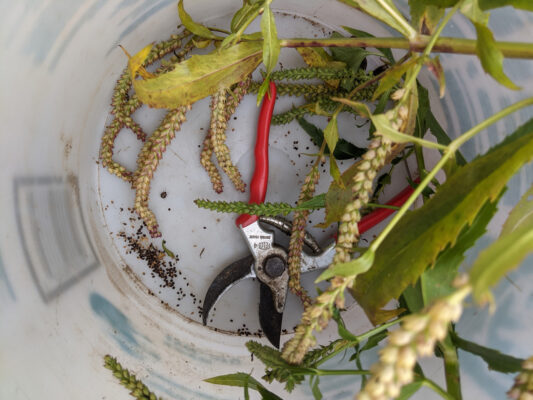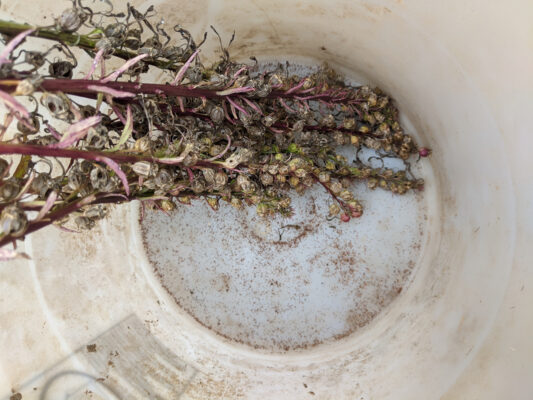As we look forward to our chapter’s annual November Seed Exchange, we encourage you to check out this blog post by member Besa Schweitzer. It can help you find and collect seeds that are available earlier than fall.
post and photos by Besa Schweitzer, chapter member
How do we tell which part is the seed? When collecting seeds from a new species it is a good idea to look at the parts of the seed head under a magnification. The seed will have a look of plumpness. Some of the seeds may look flattened or desiccated and these will probably not germinate. Healthy seed will often be the heaviest part of the flower head. If the flower is broken up and gently separated by stirring or blowing on it, the seeds will gather in the closest pile.
Compass plant and others in the Silphium genus are composite flowers. The seeds are found along the edge of the flower disk near the base of the petals. Seeds will become plumper and darker as they mature and will not mature fully if they are plucked too early. Finches and other seed eaters work their bills around the edge of the flower head to pluck the seeds out. Watching birds probe flower heads for seeds can give us an idea of where the seeds are and if they are ripe. Seeds can be separated from the chaff by breaking the seed head up and sifting out the larger seeds or picking the seeds directly off the flower head.
Some parts of flower heads, especially fleshy berries, contain germination inhibitors and should be completely separated from the seed for best germination. Using a kitchen colander to rub berries under a stream of water will wash away the pulp leaving just the skin and seed to be separated. Berries should be processed and planted immediately. In nature the fruit is eaten when ripe, digested, and then deposited in a nice fertile package of poop on the ground. Mimic natural processes as much as possible but perhaps fall short of sifting through animal scat to pick out the seeds. However, racoon poop is an excellent place to find ready to plant pawpaw seeds.
Blue lobelia, cardinal flower, and seedbox have seed that looks like dust. As the seed capsule tips in the wind or is brushed by an animal, the seeds spill out on the ground. These species grow in wet areas where the seed will be washed down hill to start new populations. These plants are often found in drifts that show where the water flows. In a garden the plants seem to be constantly moving downhill, so the gardener must scatter seeds uphill from the population to keep the plants from running away. I check if these seeds are ripe by gently tipping the seed head over in my palm to seed if any dust falls out. When the seeds are ready to be disbursed, I cut off the flowering stems to collect these seeds. While cutting, be very careful to keep them still and upright, then tip them upside down into a bucket. I let the plant stalks dry for a few days in the bucket, giving them a gentle shake every once and a while. A collection of dust will form in the bottom of the bucket; that is the seeds.
Spiderwort is a surprise for the novice seed collector as the seeds explode off the plant when they are ready. To collect spiderwort seeds, gather the flower heads after they finish blooming and just as they start to have explosions. Lay your plant stalks out on a tarp on the floor with a screen or cardboard lid over the top. As the plants dry you will hear the seeds popping off the cover. When the seeds all seem to have popped, remove the flower stalks and sweep up the seeds on the tarp.
For many species it is more bother than it is worth to separate the seed from the chaff. Flower heads can be broken up and the whole mess can be sprinkled in the new bed or stratified. This lazy method makes it harder to know how many seeds you actually have but for the home gardener that may not matter. Often when I’m collecting seeds I save the easiest to separate seeds for trading with friends or germinating indoors, the seeds that didn’t easily fall off and the rest of the chaff are all thrown into a flower bed where I hope they will establish.
Photos are of cardinal flower and obedient plant letting gravity do the work of separating out the seeds.
—
Besa
besagrows.com/book



